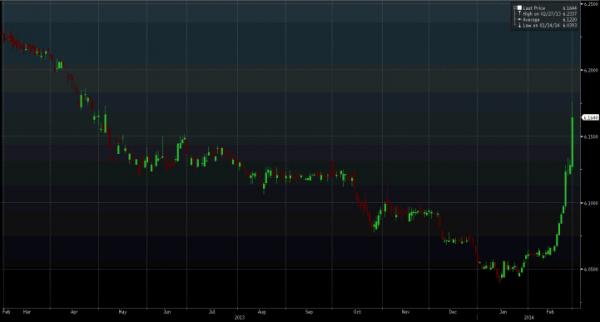And just like that the Chinese yuan devaluation has shifted away from the merely “orderly.”
In the past few hours of trading, China, which as we reported two days ago has started intervening aggressively in the Yuan market (for the reasons why, read this), has seen its currency crash by nearly 0.9%, which may not seem like much, but is in fact the largest drop since December of 2008, and at last check was trading at around 6.18, even as the PBOC fixed the CNY reference rate 0.02% higher from the last official close to 6.1214, erasing pivot support point at 6.1346 and 6.1408. Naturally this means that the obverse, the CNYUSD, has crashed to as low as 0.1620. Should this move sustain without reverting, this will be the biggest weekly loss ever!

The dramatic monthly plunge from the CNY perspetive is shown on the chart below.

There isn’t much commentary on this most recent dramatic move aside from this commenbt by Zhou Hao, a Shanghai-based economist at ANZ, who said “CNY movements indicate that the authorities are determined to deter capital inflows and there were likely stop-losses triggered when the CNY broke key psychological levels.”
What is more notable is that the move, while certainly intending to shake out the carry traders bent on riding the USDCNY ever lower, is starting to appear borderline erratic. As a reminder, and as we posted yesterday before the FT picked up the story earlier today, there is a lot of pain in store for those betting on a stronger Yuan, because while the move may not seem dramatic (by USDTRY standards), the reality is that the carry trade positions have massive leverage associated with them, with the pain level on $500 billion in existing carry trades beginning to manifest once the Yuan enters the 6.15-6.20 gap and becomes acute once the European Knock-In zone of 6.20 is crossed (see first chart below) and rising exponentially from there. In fact as we explained, should the renminbi break past 6.20 per dollar, which it is very close to right now, banks would be forced to call in collateral, accelerating the Yuan plunge, at which point the drop would become self-sustaining. The pain from that point on is around US$4.8 billion in total losses for every 0.1 above the average EKI (see third chart).
This is what we warned yesterday:

